
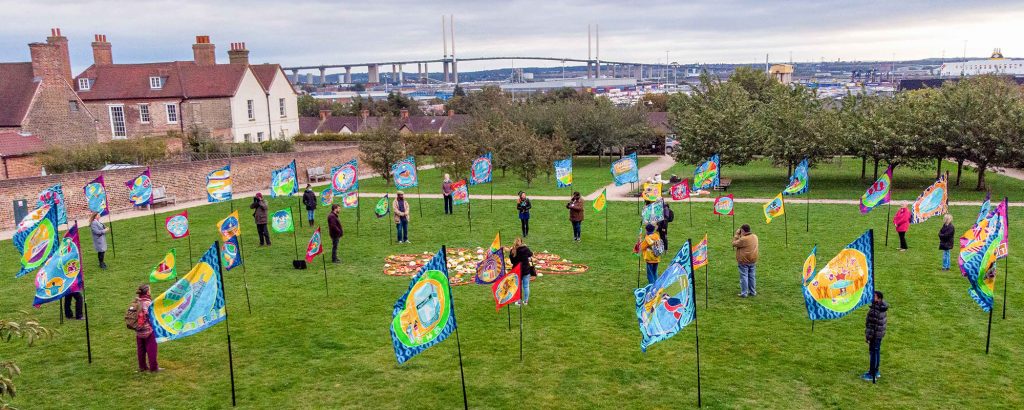
T100 is, at its core, much more than just walking. Fotis Begklis has made this series of films about the festival, about the work we did last year and the ideas behind the mandalas. There are links to the the mandala gallery pages at the bottom of this page to see more images, and the project evaluation report to evidence the impact.
A film about the T100 Festival by Fotis Begklis.
“It’s about a call to action to imagine the future, as residents of Thurrock … and how are we going to think about what values would we like to be living by as humans.”
“We knew that we were going to use the mandala making as a way of thinking about the future and that each mandala would represent a different focus and use that exercise of creating a mandala to start a conversation in each of the communities about what could be different. What could we do to make our community different? So each mandala has a theme.” Ali Pretty
Ali Pretty 0:06
T100 is a festival that’s now in its sixth year. It was 2015, that we started, I was approached by the public health department of Thurrock Council to start a walking Arts Festival in Thurrock. It started like walking and discovering the places of Thurrock discovering the heritage, the different landscapes. In more recent years, the diversity of the communities in each of the different places their different perspectives, how they feel connected, or not.
Lesley Robinson T100 volunteer 0:38
I walk so I kind of know bits of Thurrock. But what’s happened along the way is we’ve met people who don’t know Thurrock, they’ve lived here, and they don’t know their neighbourhoods. So it’s been really good, people walking.
Ali Pretty 0:54
This is called T100 Calling 2020. And it’s about a call to action to imagine the future, as residents of Thurrock, as residents of Tilbury, or Purfleet, our micro futures if you like, and how are we going to think about what values would we like to be living by as humans.
Winnie Nyamu T100 Volunteer 1:22
I started a walking group called Tilbury walking group. And I started getting more and more people who wanted to be shown around Tilbury because they were new into the area who wanted also to walk but they were not able to walk on their own. And we keep meeting new friends every time. And it gives me the opportunity now even to spread the word in my community inviting a lot of people to come. And my highlight was the carnival last year in Tilbury.
Ali Pretty 1:55
This year marks a bit of a shift change over the last five years. And that kind of coincides with a three year phase of the project, which is to really explore what is T100 in itself, what is the purpose of the festival, and looks towards a future of what Thurrock itself is and what Thurrock communities would like to see. Thurrock is a collection of different communities, and therefore offers a huge amount of diversity in terms of the geography, the industrial, rural, and the different kinds of people that live in those places.
Sharon Philips, T100 volunteer 2:32
I’ve been involved with Thurrock 100 since inception, I’ve been an attendee every year. It started off really, it was walking 10 miles each day for 10 days. It’s been different every year. I love the outdoors. I love art. I’m interested in local history, so it just been perfect for me.
Ali Pretty 2:52
I feel that over the last five years, we’ve laid a foundation of getting to know people getting to know the place and building up a trust that we’ve got a trusted group of very committed volunteers from different parts of the borough. So this year was always going to be about building on that foundation and starting to look forwards. So it’s kind of more future thinking. We knew that we were going to use the mandala making as a way of thinking about the future and that each mandala would represent a different focus and use that exercise of creating a mandala to start a conversation in each of the communities about what could be different. What could we do to make our community different? So each mandala has a theme. And they have developed over the period of lockdown as well, because we did some of this work online in May.
Katie Beadle T100 Project Manager 3:41
We were in lockdown. How do you engage people when you can’t meet anybody. We tried to work in a new way. And we found new ways to work. And that’s why we set up the T100 walking arts Facebook group because it allowed us to have a community we developed a resource pack. We printed 50 bespoke packs, which we were designed again by local artists. And we printed them and we posted them. It was a glimmer of hope and really dark time that it really did. It made us feel that we were able to still achieve something together and we were still able to communicate and reflect on those themes which actually became and felt ever more prevalent in that time.
Sally Chinea, artist 4:28
This year, I took more of an artist role in designing and making the large scale objects. I work in a school, so I got children involved in T100. So last year, it was lovely to have our school from Southend involved in T100 because some had never been to Thurrock.
Katie Beadle T100 Project Manager 4:47
And we managed to engage up to 250 participants physically coming to the events. We work with up to 30 partner organisations as well as the 25 community groups that made their flags for the finale aspect, we worked with 17 artists, we were able to commission throughout the festival.
Jackie Doyle-Price MP for Thurrock 5:09
One of the things that I love about Thurrock is, and we’re a tiny little place, but but we’re fighters and we, we keep pushing, and we have so much unrealized ambition here. And that we can all make sure is realised by coming together, all these communities have their own distinct vibe and personality and and I think one of the things that you’ve captured beautifully, since you’ve been here is working with those individual communities and really bringing them together.
Ali Pretty 5:41
2020 really propelled us into more focused action than we’ve ever had before, to aggressively imagine our future. And the moment that we’re in internationally and nationally and locally, it’s even more important to think how are we going to live differently, how are our values going to have to change to have a sustainable future.
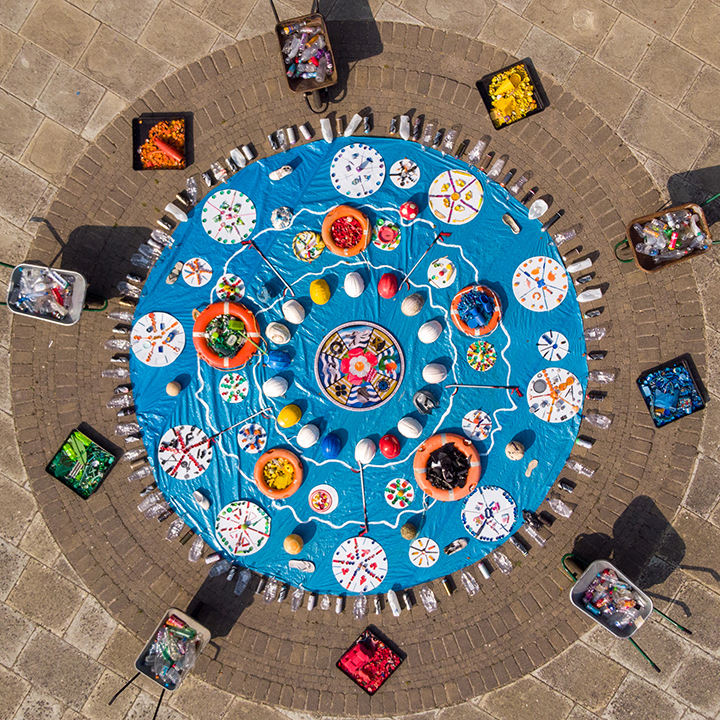
“We all have a responsibility to try and reduce the amount of plastic we’re using.” Steve Catchpole, River Action Group clean up facilitator
A film by Fotis Begklis about the Spring Clean Mandala in Grays.
This mandala in Grays was inspired by Steve Catchpole and his team of Thames 21 volunteers who worked for nearly a year to gather, sort and clean items of plastic that had collected from the Thames foreshore. He explained all about it as we assembled this brightly coloured mandala, with the centrepiece created by Hi Ching, artistic director of Thurrock Festival, and the outer areas designed by Kara Thompson with local Thurrock CVS Volunteers and Thurrock Young Carers.
If you’re feeling inspired to take action and help to clean up your local foreshore, find out more from Thames 21
Or volunteer for Rivercare and find out how to protect a river and save the sea.
Steve Catchpole, River Action Group clean up facilitator 0:14
That sound is probably similar to the sound we get when we walk across the reef beds, with the plastic under our feet. You hear the crunching because there’s so much plastic underneath our feet. That all of these hard hats and all the rest of the plastic, the life buoys and everything else, have all come out of the river in local cleanups. As with everybody who actually sees the plastic that’s coming down the river, they are all flabbergasted. It’s just mind boggling to see how much rubbish comes out. And when, when you look here, you know, we’ve got hard hats, bottle tops, cotton buds, lollipop sticks. This has come from only a few [clean up] events, we’re talking about 1000s of sackfuls of rubbish.
Ali Pretty 1:11
The theme is called Spring Clean, and working with the Thames 21 volunteers, they have been collecting plastic from the river since October. And the man who’s leading it, Steve Catchpole, told me he regularly organises these river clean ups. he calls them litter picks, and that they collect all this plastic from the Thames.
Steve Catchpole 1:34
I’ve been doing it for 4 years, there was a Thames 21 event, an annual event that happened in Gray’s about four years ago. And after the event, I turned around to local residents and said shall we come and do this again next month? And they agreed and every month until the start of the pandemic in March, we had held a monthly pick.
Ali Pretty 1:57
So he had just offered me the answer about what the mandala should be in Grays because I was like, well, if you pick up all this plastic, what do you do with it. And perhaps we could do something to raise awareness of how much plastic comes out of the river by creating a piece of art. There was almost a whole year of actually sorting and collecting it, and then thinking about it. He has been storing it in his shed in his back garden. He’s sorted it out into these beautiful piles of coloured plastic.
Kara Thompson, local artist for Grays mandala 2:27
So the mandala I’m making at the moment is made out of the plastics that came out of the Thames that have been found by the litter picking team. They’ve all been cleaned by Steve. So we know that these are safe to be using for this. And we are using two colours of plastics on each one. So it looks really good on the mandorla. But also, it’s really good to highlight the variety of plastics that are found in the Thames. So on here, for example, I’ve got pens, I’ve got a lighter, bottle lids, and even the middle bits of kinder eggs.
Young Carer, local volunteer 3:01
Pick up the trash. And then they gave it to us to make our mandalas. And I found him in the trays. Well, I used plastic, that was a main thing. But there was also like glass and well, there was quite a lot. And for the other young carers, I saw that there was actually boots and leather
Kara Thompson 3:24
We’re encouraging people to realise the amount of plastic that ends up in the water; made it a really exciting project to work on.
Katie Beadle T100 Project Manager 3:33
We’re trying to raise a really important awareness of a really important theme of plastic pollution and the issues arising from the Thames and the wonderful work that Steve and Thames 21 are doing to try and clean up the Thames along that area. But it’s a massive task just for them. And it was really important to Steve that we were not only highlighting the issue, but he said he really wanted to kind of shock people with the things that he was finding and collecting because he just thought people aren’t aware and to hopefully, kind of make them engage with with that, and it’s not going to be an issue in the back of their mind.
Steve Catchpole 4:05
Not all of this is people flytipping this is just us using plastic when we don’t really need to. And ultimately, some of it will get into the river and be part of the problem. We all have a responsibility to try and reduce the amount of plastic we’re using.
Sharon Philips, local volunteer 4:22
I hate litter. So to come down to the beach today be involved in putting together mandala with all the rubbish that Steve has collected, it’s been great.
Katie Beadle T100 Project Manager 4:28
It felt really powerful, really poignant in that it was I felt like a physical representation of seeing the community come together because you were able to physically see different people working in mini bubbles and then all pulling it together and then right at the very end, realising the kind of how important everybody’s little part is to making a whole and making something great together.
Steve Catchpole 4:57
I now run events all the way along the river. From Rainham in Essex, through to Stanford-le-Hope, I normally have 20 to 30 people going out on an event, one and a half hours on a Sunday morning, every month, religiously, so that we’re keeping on top of the problem. Hopefully, we will actually get government involvement to actually try and tackle the problem with. We’re finding smartie lids, which we know are 35 to 45 years old. The rubbish is not going anywhere. We make a small dent in the problem. We look we’re not solving the problem. Anybody who thinks that litter pickers will solve the problem are kidding themselves. We are just focusing attention on it.
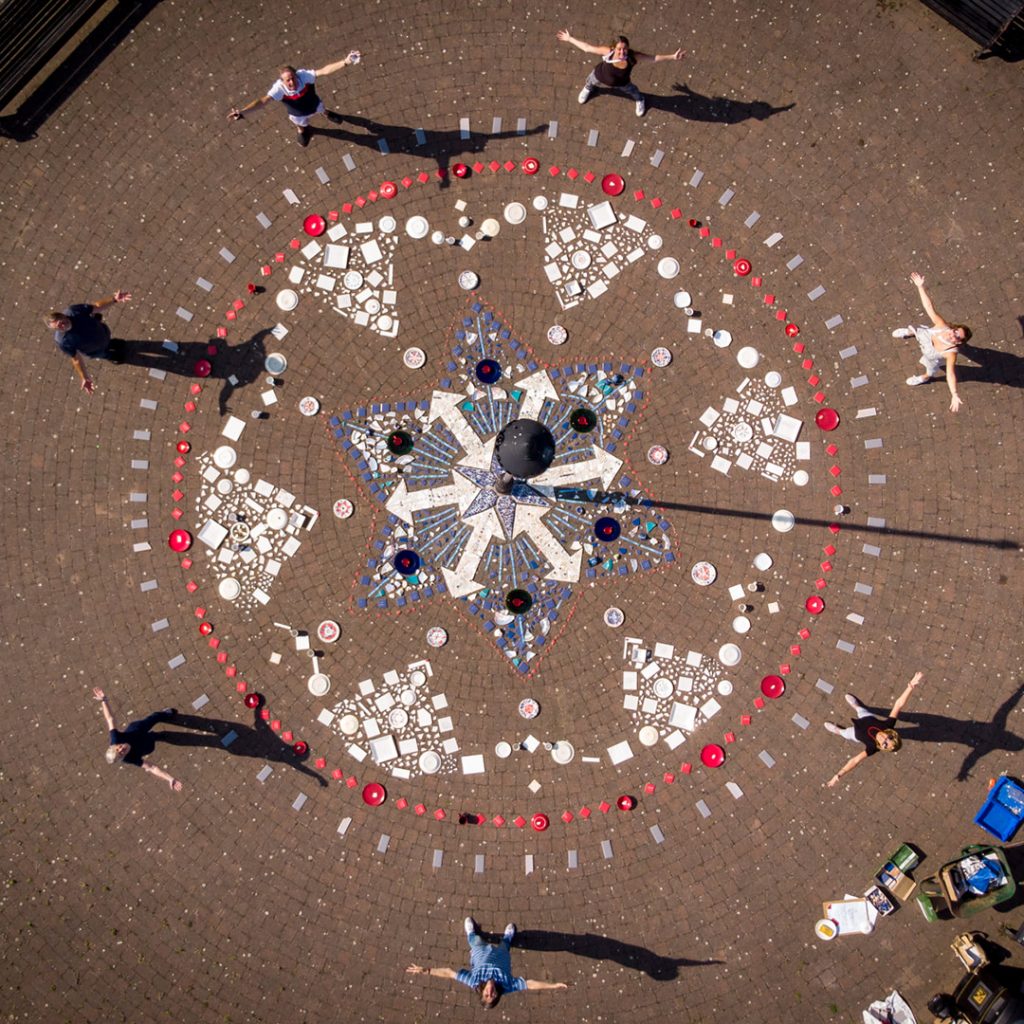
“The Make Do and Mend theme was about reclaiming community spaces and making use of a really disused space, the bandstand. Having been born in Tilbury, I didn’t even know it was there. So it highlights how important it is that we were reclaiming that space for ourselves.” Katie Beadle, T100 Project Manager
A film by Fotis Begklis about the Make Do and Mend mandala in Tilbury.
Local T100 volunteers, Les Morgan, Winnie Nyamu and Melvin Ndebele cleaned it up, in preparation for an impressive assembly of ceramics inspired by the logo of the Port of Tilbury and designed by Sarah Doyle and Sally Chinea with participation from Thurrock Youth Services.
“It was in this spot in 2017, where we walked along the river for our project, and we were with a guardian journalist, Kevin Rushby. When the tide went out, he couldn’t believe how much the foreshore was glistening. It was glistening with broken pieces of glass, broken pieces of ceramic, washed up in the tides ever since the Blitz. He wrote ‘what dreams were shattered when the bombs went off. This is the beach of broken dreams.’ That sowed the seed of the idea for the Beach of Dreams, and T100 Dreaming, about collecting the gems around the UK foreshore, and in this case, the gems of Tilbury.
Here we have all of these wonderful people that live here, who are the gems of the community. And our vision is if can pick up those gems and put them together. We go from the beach of broken dreams to the Beach of Dreams.” Ali Pretty
Les Morgan 0:04
Les Morgan: So this area here we’re sitting, I think it was done by the Port as a viewing place for people to view the river. I don’t think it’s used as much as it should be and it’s not maintained. I really do get annoyed that a place like this is not maintained. We’ve got the perfect riverfront here for them to walk along here and along the seawall, so we’ve got keep it looking nice.
Katie Beadle T100 Project Manager 0:38
Katie Beadle: The Make Do and Mend theme was about reclaiming community spaces and making use of a really disused space, the bandstand. Having been born in Tilbury, I didn’t even know it was there. So it highlights how important it is that we were reclaiming that space for ourselves. And no one really took ownership of that space and therefore really needed a bit of care and attention.
Sally Chinea, artist 1:05
The Make Do and Mend theme to me was a gift when Ali asked me to take part in this, because my own practice is very much about that, making do and mend, or reusing things, and finding a way using old traditional craft skills. I think that actually, how can you fix this? How could you mend this? How can you make this into something beautiful that someone could use again?
Lesley Robinson T100 volunteer 1:25
It’s not recycling, it’s using, it’s reusing things around them. And getting people to think of, of what they could use things for before they abandon them to the dustbin, or wherever they abandoned stuff to.
Sarah Doyle, artist 1:45
A lot of my inspiration for getting involved in this project has come from my nan, my dad actually passed away just in March, and she was 90 years old. And a lot of my artistic inspiration does come from her. This, I’ve actually included her in this mendala some of her old cups of ceramics and things are used to form part of this. So she’s very much still alive and still a part of our mendala. And our project community meant a lot to her.
Katie Beadle T100 Project Manager 2:29
It was through the hard work and commitment of our volunteers that we were able to reclaim it, people were taking the responsibility themselves to look after their own area. And that was the residing message that was going through which then is obviously a really important one to be spreading that you know for people to take pride and and fix the issues that they see in their own area and as a result make a commitment to taking care of that space.
Sarah Doyle, artist 2:51
A great deal of the materials have just been donated. So we have just put out a call on social media in the local area and asked for any unwanted ceramics. And specifically because we are breaking them we did we know it didn’t matter if they were broken if they were chipped. Because our make to amend theme would require us to make something beautiful out of things that are broken.
Ali Pretty 3:21
It was in this spot that we were here in 2017, where we walked along the river for our project, and we were with a guardian journalist called Kevin Rushby. And when he came to the foreshore when the tide went out, he couldn’t believe how much the foreshore was glistening. It was glistening with broken pieces of glass, broken pieces of ceramic. And why that happens is because it keeps getting washed up in the tides from ever since the Blitz. So when the Blitz went off, households were bombed. And he wrote what dreams were shattered when the bombs went off.
This is the beach of broken dreams. So that sowed the seed of the idea for this project that we’re starting this year. It’s about collecting the gems around the UK foreshore. And in this case, the gems of Tilbury and here we have all of these wonderful people that live here, who are the gems of the community. And our vision is if can pick up those gems and put them together. We go from the beach of broken dreams to the Beach of Dreams.
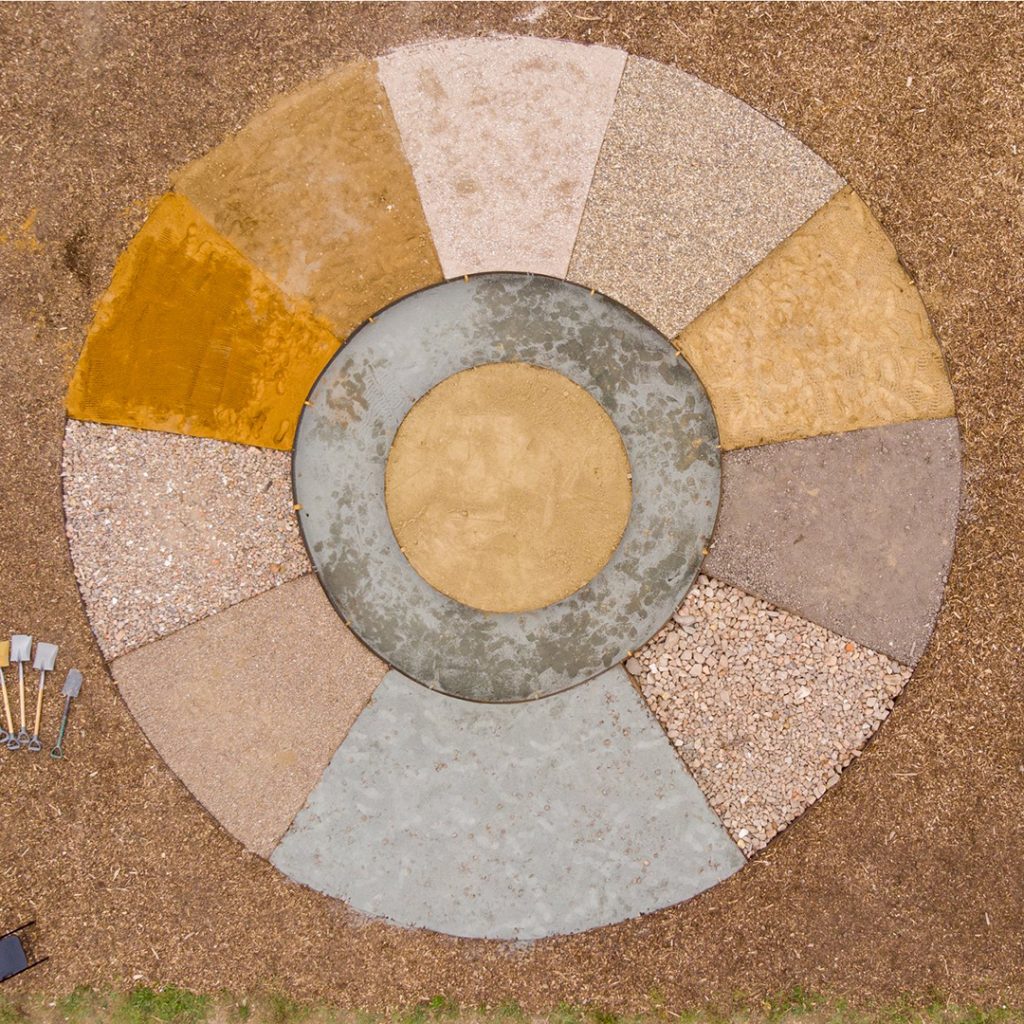
“This place is going to become very important for wildlife” John Little, Grass Roof Company
A film by Fotis Begklis about the new insect habitat mandala made at Little Belhus Country Park for T100 festival 2020.
In collaboration with Rural Arisings, and designed by John Little of the Grass Roof Company, we shovelled rubble, brick and broken ceramic into the steel frame of this giant mandala, which will soon become a permanent insect habitat.
Richard Scott, from Scouse Flowerhouse and Director of the National Wildflower Centre of the Eden Project, brought wildflower seeds and collectively with artists Shannon Topliss and Lesley Robinson and a team of Thurrock Young Carers, we scattered buckets of seed that will burst into a riot of colour.
John Little, Grass Roof Company 0:07
Thurrock, being a place that’s traditionally, for probably the last 40, 50 years been dumped on. So it’s a place that people have brought their rubbish to.
Lesley Robinson, volunteer 0:18
I’m actually standing on a landfill site. Because Thurrock is well known for the holes in the ground that people fill up with rubbish, and then eventually they’re capped off,
Dhruti Bell, Countryside Manager, Rural Arising 0:30
This area was about three meters lower, just where the original landfill depth. The mandala is, well, it’s the brainchild really of Kinetika. And it’s part of the T100 Festival. So when Ali came and spoke to us about the idea, we thought that we could make it out of construction materials,
John Little, Grass Roof Company 1:01
We designed a structure out of steel, because we were very keen to make something that would last. A steel structure, that segments a mandala shape into nine different segments.
Lesley Robinson, volunteer 1:16
My section here is full of ground up porcelain, and tiles. So this used to be somebodies bathroom.
Richard Scott, Dir National Wildflower Centre at The Eden Project 1:29
A lot of these landfill sites can be a really imaginative use for them, rather than cover these materials with topsoil and just change them to grass and tree landscapes. We probably don’t have that much biodiversity.
Dhruti Bell, Countryside Manager, Rural Arising 1:42
It’s mini open mosaic habitats, a sort of microcosm, and it’s very beneficial to wildlife, particularly insects and invertebrates. And it’s sort of a visitor friendly version of what we’re going to be putting out into the field.
Lesley Robinson, volunteer 1:58
Laying down, there’s different types of sand, stone and gravel, and we’re eventually going to seed it. So if you come back next year, each section of this mandala, there will be different plants growing, different colored flowers.
John Little, Grass Roof Company 2:13
This place is going to become very important for wildlife and it’s in South Ockenden. And it’s going to be on the back of all the stuff that basically we don’t want. So it’s that kind of whole double whammy of reusing materials that is our waste and creating an amazing space.
Lesley Robinson, volunteer 2:30
And once we get going with this, we are hoping to really involve the local community who are literally just across the road.
John Little, Grass Roof Company 2:41
It’s a wonderful process, and kids love it. And you don’t have to be picky about it, you don’t have to be precise about it, the seeds go in, and then next year, then the kids turn up there will be full on flowers here, you know, and it’s it’s that simple and cheap.
Lesley Robinson, volunteer 2:56
And turn this site into something that people will love to come and sit in, walk around, bring their children. So this site has a lot of potential to involve a lot of local people.
Richard Scott, Dir National Wildflower Centre at The Eden Project 3:12
It’s kind of creative conservation has been created with ideas and just creating curiosity and making people think about the relationship with the land. When land presents itself in this way, and you get a collection of people coming together, it is very exciting. So I think it’s a great to collaborate with other people; blend the arts, and the landscape and science all in one.
John Little, Grass Roof Company 3:41
Ecologists can come and study it, they can access it really easily. And it’s just going to be a little template really, for what might happen in the rest of the park. And it is one of the most exciting things really to have what is a completely blank canvas, to start a path.
Richard Scott, Dir National Wildflower Centre at The Eden Project 3:57
It’s seeing is believing. It is about showing people what you can do and if other people then can come, they also believe it’s possible. You know, if people don’t see things they won’t believe it’s possible. For people to experience that directly in the landscape, in an urban place where people live, is exceptionally important.
John Little, Grass Roof Company 4:21
Creating new brownfield landscape, which is in effect what we’re trying to do here, is very unusual. It shouldn’t be, but it’s really unusual. And we’re really hoping that this could be the place, this could be the kickstart of really looking at this as an interest in having an important habitat and Little Belhus Park and South Ockenden could be the place where it started.
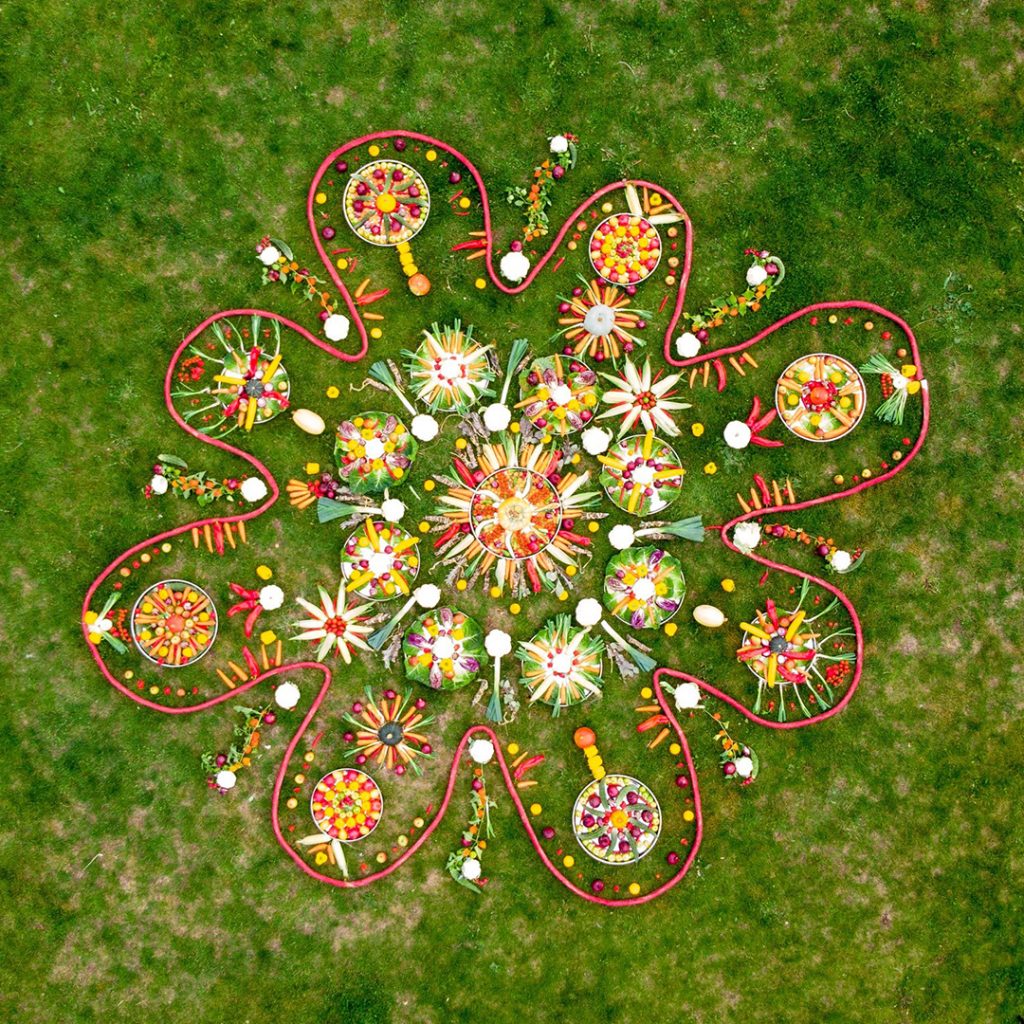
“This mandala, more than any other, was where I think we created significant conversations that we can build on. Because lots of people met each other for the first time, and to be working collectively, so the arts can be at the center and the leader of the regeneration, is something that as absolutely part of our values at Kinetika is what we’ve always done. We’ve always worked to empower communities wherever they are.” Ali Pretty
A film by Fotis Begklis about the Grow Your Own mandala created in Purfleet-on-Thames.
Zyle Mills from Heavenly Greens alongside artist Sofie Layton, Winnie Nyamu and Gemma White, led on the mandala that reflected the diversity of the population there. It was the beginning of a wider conversation about how local people and the artist community at High House Production Park can come together to creatively imagine their future in the next few years to put this little-known gem on the banks of the Thames on the map.
Ali Pretty 0:33
Purfleet is our home in terms of Kinetika has our studio in Purfleet, and is undergoing a huge transformation in the next 10 to 15 years. And that the communities that live here with the industry, the old industry has collapsed. And the new industry is coming that it’s going to be a huge time of transition, the population of Purfleet, and it’s very small, and it’s going to become much bigger over the next 10 years. And now’s the time to really come together to work together with the different stakeholders to think about how we grow our own community.
Katie Beadle T100 Project Manager 1:10
We knew that we wanted to outreach into the community, the Grow Your Own theme wasn’t necessarily just about growing your own produce and being more sustainable, but about growing your own community.
Sofie Layton, artist 1:23
The participants are contributing to the overall design, I just helped create a structure. And I’ve with Zyle created this material that we’re making the structure out of which is the vegetables and the fruit. But ultimately, it’s about the participants imagination and taking inspiration from that and then developing it on.
Katie Beadle T100 Project Manager 2:06
The theme itself was Grow Your Own. But we hadn’t been able to connect with all the different allotments or different households and schools to say, you know, you could be growing these things throughout these whole months ready for the festival. And because we couldn’t go there to ask them to do that, and the schools weren’t open, we couldn’t encourage as many people as we would have liked to be growing your own and Zyle from Heavenly Greens, fruit and veg came on board to support us and make sure that we were helping a local business while the local business was helping us.
Zyle Mills Heavenly Greens 2:35
And one of the initial ways in which Heavenly Greens fruit and veg had been engaged in the event was to produce a flag as a part of the community. And out of that, because I run a fruit and veg business, the idea for the mandala came about. I’m quite the appropriate person to talk to in terms of sourcing food and veg, which would be in season, which would be able to keep and hold its form and shape on days like today.
Katie Beadle T100 Project Manager 3:13
The challenge was actually getting the materials to make the mandala, and how can you design it when you don’t know what materials you’ve got. So we were really lucky to have Sofie on board and Winnie and Gemma, some local artists who we engaged with this year to work with Sophie, and to kind of come up with the design and they worked really closely with Zyle. It was a really collaborative feel.
Sofie Layton, artist 3:38
I keep imagining myself as a bird, and looking down on it, and what would I see from above. You’re trying to design something that works in detail, but also being aware that you’re trying to create something that’s a bigger picture.
Katie Beadle T100 Project Manager 4:05
The idea was that at the end of the mandala make, we would load the mandala materials into bags and then redistribute them to community. Because one of my concerns was that what’s going to happen to these materials, so it wasn’t just this one, it was all the mandalas; what will happen to them at the end? People have worked really hard to grow their resources, we don’t want to waste them. But then with the pandemic, we couldn’t just have this wonderful feast at the end that we might have dreamt of. And so this was a really good solution. That meant that nothing went to waste. But actually it further pushed the theme forward in that it meant we were growing those communities because we were sharing and and swapping and given for free.
Ali Pretty 4:54
This mandala, more than any other, was where I think we created significant conversations that we can build on. Because lots of people met each other for the first time, and to be working collectively, so the arts can be at the center and the leader of the regeneration, is something that as absolutely part of our values at Kinetika is what we’ve always done. We’ve always worked to empower communities wherever they are.

The mandala themed activities of the T100 2020 festival had wide-reaching community impact.
Read the extensive evaluation report by clicking on the button below.
To be part of future activities and find out how to get involved with the development of T100 into its own community-led organisation, please contact us.
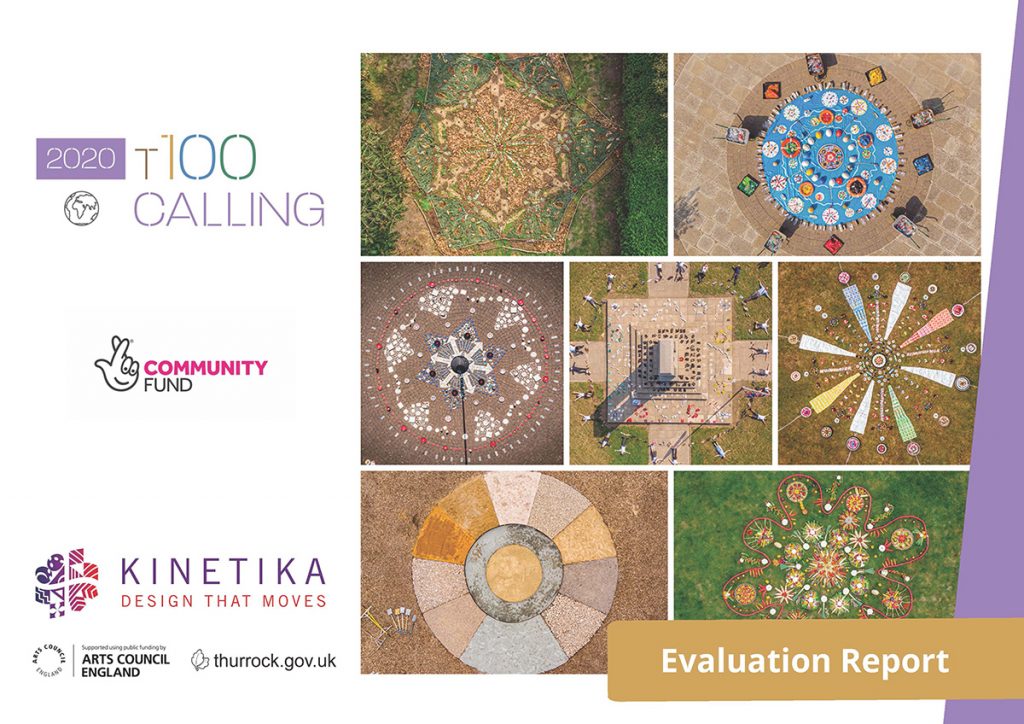
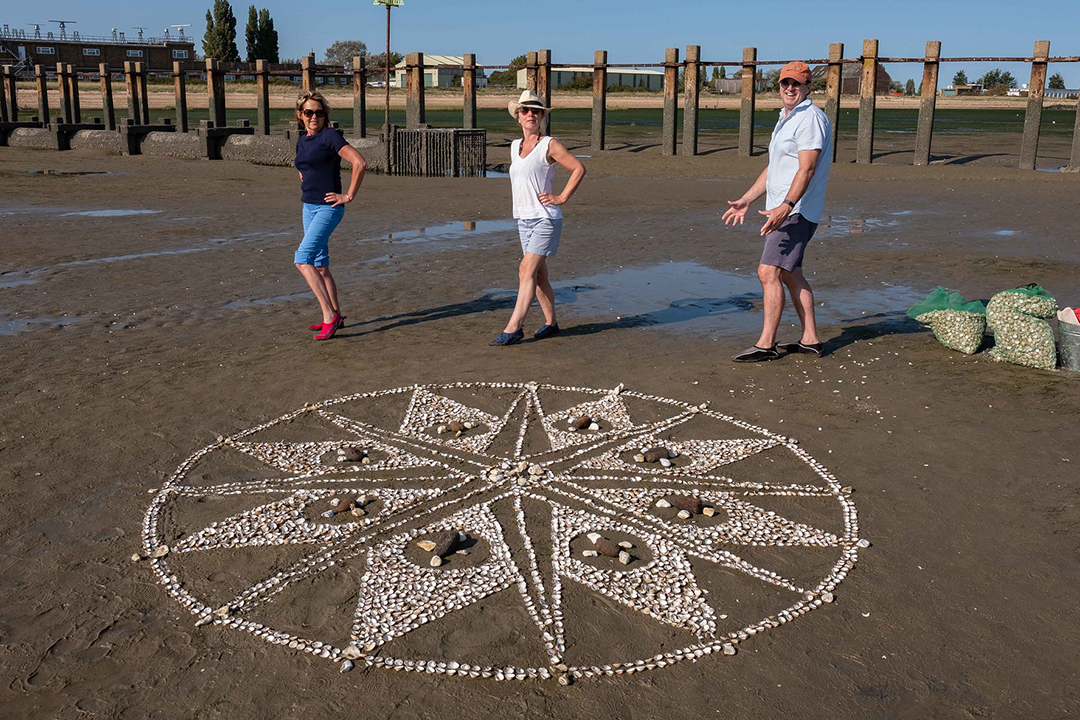
Thurrock 100 would like to extend a huge thank you to its funders and delivery partners for T100 Calling 2020
[rl_gallery id=”10338″] [rl_gallery id=”10325″]T100 2021 JUNE WALKS
Tilbury Walk Page Grays Walk Page East Tilbury Walk Purfleet Walk Page ABOUT T100